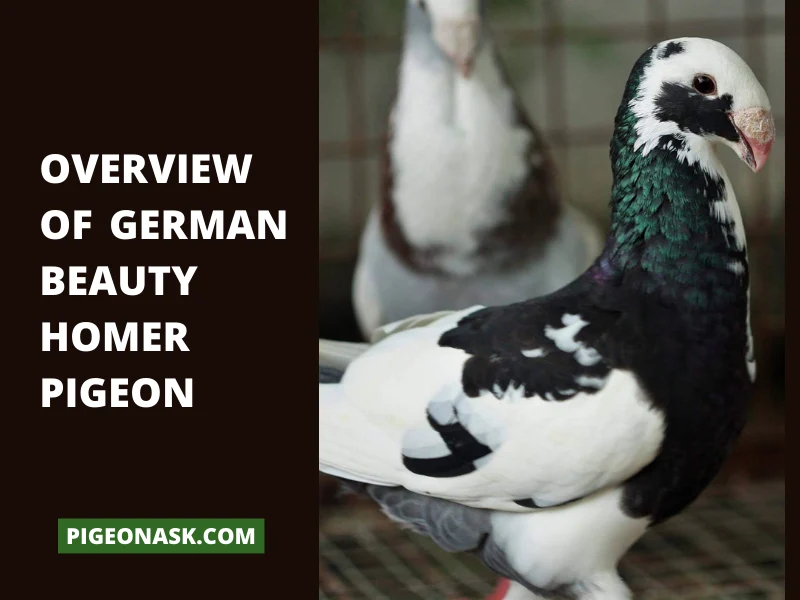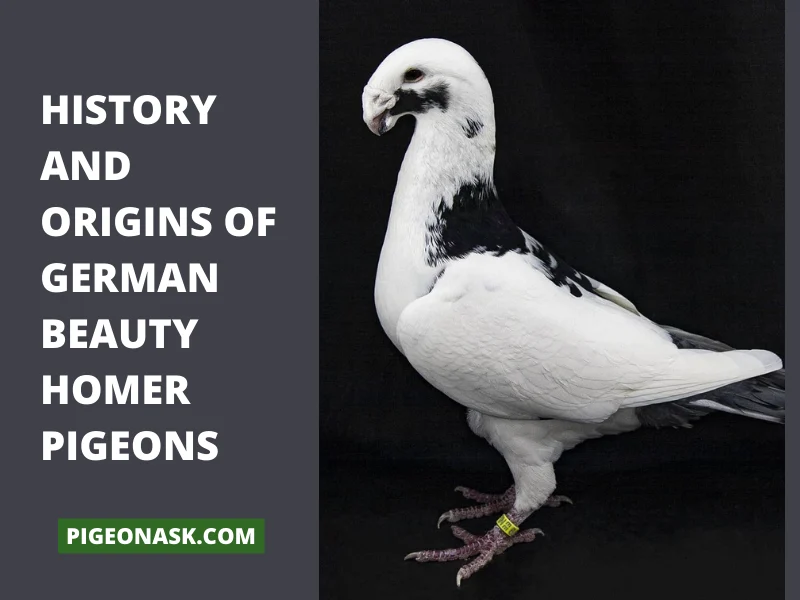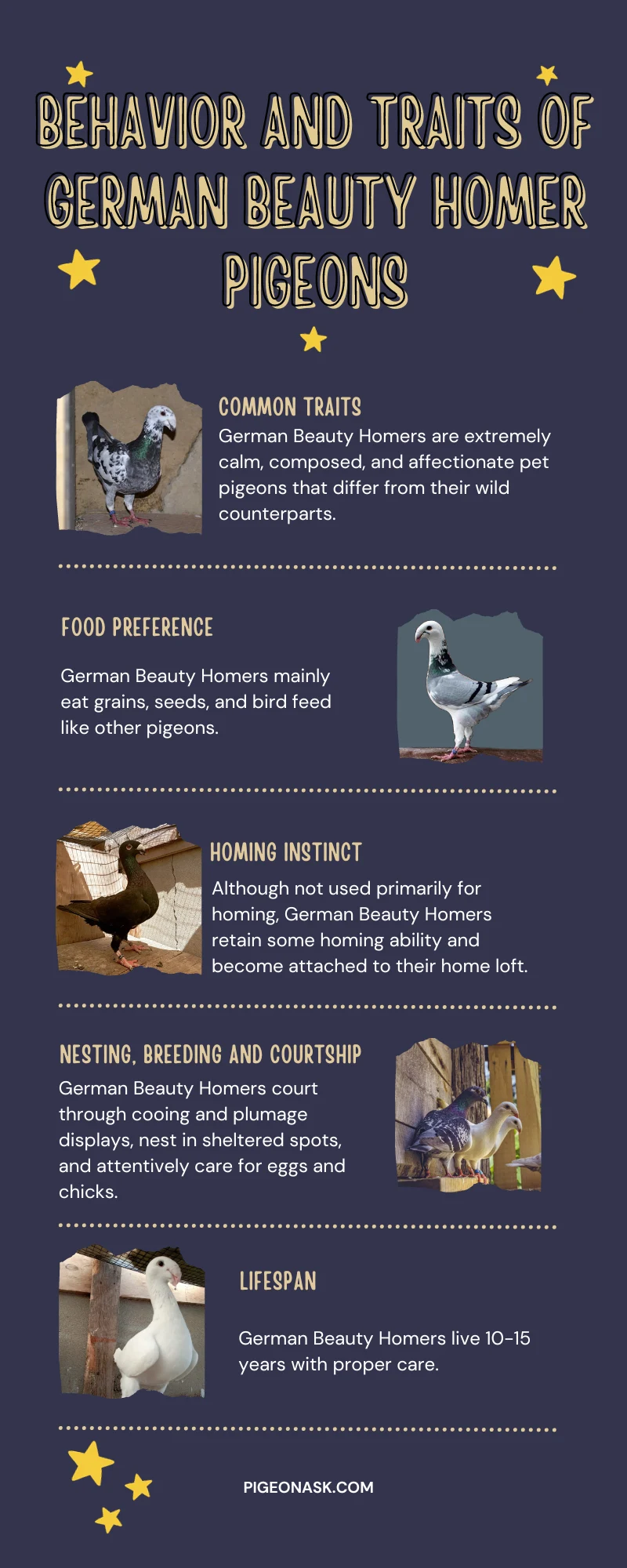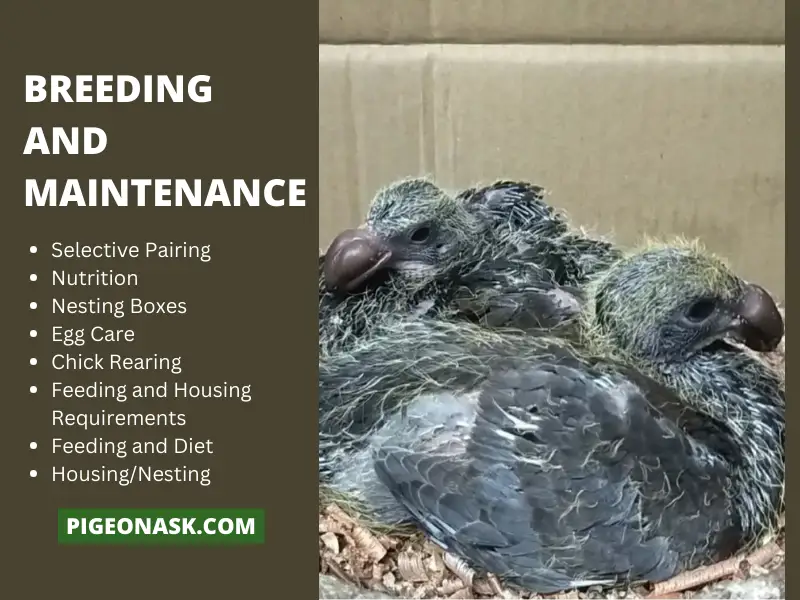German Beauty Homer Pigeon: Breed Guide
In the world of aesthetic pigeon breeding, the German Beauty Homer is a renowned breed.
Valued by their alluring physical appeal and grace, this pigeon breed is in high demand for those who want to sign up for pigeon beauty shows and pageants.
In this guide, we will dive deep into the details regarding the German Beauty Homer, their origins, personality, physical traits, and more. You will learn about how to take care of them, along with some tricks and tips for better breeding.
So, stick until the end of this guide, and you will become an expert on German Beauty Homers in no time.
German Beauty Homer Pigeon Profile
| Name | Details |
|---|---|
| Scientific Name: | Columba livia domestica |
| Common Names: | Schonheitsbrieftauben, German Beauty Pigeon, Letter Pigeons of Beauty, German Show Pigeon |
| Origin: | Germany |
| Size: | Average/Medium |
| Weight: | 480g – 580g |
| Lifespan: | 10 – 15 years |
| Physical Features: | Semi-circular head with straight lower mandible, Fan-shaped tail |
| Temperament: | Calm, gentle & friendly |
| Behavior: | Calm & composed |
| Special Features: | Striking white colored feathers with different shades |
| Breeding and Maintenance: | Bred for aesthetic purposes, requires heavy care & attention. |
| Common or Popular Varieties: | White-colored German Beauty Homer |
Interested in similar topics on pigeon breed:
Overview Of German Beauty Homer Pigeon
The German Beauty Homer Pigeon is a breed that combines aesthetic beauty with a calm and gentle temperament. Originating from Germany, these pigeons have become popular among enthusiasts and breeders alike.

Their diverse colored feathers result from years of selective breeding and are the primary aesthetic point that makes them stand out. Followed by their distinctive tail and sociable nature make them a prized addition to any pigeon collection.
However, it’s essential to remember that their care demands attention to detail, particularly when it comes to breeding and maintaining their unique appearance.
Whether you’re looking to enter the world of pigeon beauty shows or simply seeking a delightful and elegant pet, the German Beauty Homer is a splendid choice.
We have covered an in-depth article on “Homer and Hen Pigeons“; if interested, you can read our article!
History And Origins of German Beauty Homer Pigeons
Origin
As you can guess from the name, the history and origin of German Beauty Homer pigeons date back to Germany, in the early 1900s, to be exact. German fanciers developed these birds primarily for showcase and later for delivery purposes.

Their German name ‘Schonheitsbrieftauben‘ means ‘Letter Pigeons of Beauty.’
When they were first developed, German fanciers only had physical beauty in mind, as supported by their names.
Later, when Hitler commanded the use of all German pigeons for the war effort, is when the German Beauty Homer was used for their homing and messenger capabilities.
Breeding History
The journey of creating German Beauty Homer Pigeons centered on perfecting their plumage.
Their hallmark is their dazzling white feathers, which serve as a pristine canvas for the hues adorning their wing shields-shades like red, yellow, blue, black, and silver, meticulously bred over generations.
In the quest for perfection, breeders also honed other physical attributes. Their semi-circular head, straight lower mandible, and distinctive fan-shaped tail contribute to their unique and graceful appearance.
Though it involved trial and error, breeders were able to transcend German Beauty Homers from being ornamental birds of the 20th century to the cherished stars of pigeon beauty shows of the present.
Physical Characteristics And Features
German Beauty Homer pigeons are distinguished by their exquisite appearance and the harmonious interplay of colors on their feathers. Their physical attributes and qualities make them stand out as the true embodiment of avian elegance and beauty.

Appearance
The captivating appearance of German Beauty Homer pigeons sets them apart from other pigeon breeds.
Their heads boast a semi-circular shape and a straight lower mandible, contributing to their elegant and distinguished look. But it’s their plumage that truly sets them apart.
These pigeons are characterized by striking white feathers that serve as a brilliant canvas for a symphony of colors found on their wing shields.
But there are new breeds that have completely overcome the white plumage and now have mixed or other solid color plumage.
Size and Body Structure
In terms of size, German Beauty Homers fall into the category of medium-sized pigeons. Their physique is well-proportioned, showcasing a harmonious balance of grace and presence.
And their body structure, neither too large nor too small, accentuates their overall appeal and poise.
Weight
The weight of German Beauty Homer Pigeons typically ranges between 480g to 580g, providing them with a sturdy yet agile frame. There isn’t any significant weight difference between male and female German Beauty Homer pigeons.
Unique Features
One of the most distinctive features of German Beauty Homers is their fan-shaped tail. With its elegant and fan-like arrangement of feathers, this tail adds an extra layer of allure to its appearance.
When these pigeons are in motion or perched gracefully, the fan-shaped tail becomes a captivating focal point, further enhancing their overall charm.
Another unique feature would be their semi-circular head with a completely straight lower mandible. Other pigeons don’t have this physical trait, which sets German Beauty Homer pigeons further apart from other breeds.
Variations in Colors and Markings
While the foundation of their plumage is a brilliant white, German Beauty Homers exhibit a delightful variety of colors like sliver, black, red, blue, yellow-green, and markings on their wing shields.
The precise combination of colors and markings can vary from bird to bird, making each one a unique work of avian art. There are also completely mixed-colored German Beauty Homer pigeons resulting from selective breeding.
This variability of these birds keeps enthusiasts and breeders captivated as they seek to appreciate and refine the diverse range of colorations across the species.
Distribution And Habitat
Have a look at the habitat distributions of the German Beauty Homer pigeon –

Geographic Distribution
German Beauty Homer Pigeons, despite their name, are not confined to Germany alone. They have gained popularity and found homes in various parts of the world.
Their geographic distribution extends beyond their country of origin, making them a global phenomenon. Enthusiasts and breeders around the globe have embraced these pigeons for their stunning beauty and distinct charm.
Habitat Preferences
In terms of habitat preferences, German Beauty Homers are versatile and adaptable.
They can adjust to various environments but thrive in environments that provide them with adequate shelter, safety, and access to food rather than in the wild.
Because they have been bred in close care for generations, they have become too comfortable and reliant on human care.
Urban and Rural Habitats
German Beauty Homer Pigeons have comfortably transitioned from rural to urban habitats. They are equally at home in the bustling cities as they are in more rural settings.
Many enthusiasts keep them in urban environments as pets or for participation in beauty shows, while others may maintain them in more rural areas, provided they meet their basic needs.
Migration and Seasonal Movements
Unlike some bird species, German Beauty Homer Pigeons are not known for long-distance migrations or seasonal movements.
As most German Beauty Homer pigeons are raised in close observation and care, over the years, they’ve rejected the need for migration.
They tend to stay in one location, often their place of residence, throughout the year.
This sedentary behavior aligns with their role as pets or show birds, which typically do not migrate.
Threats and Conservation Status
German Beauty Homer Pigeons are not classified as a threatened or endangered species, as they are primarily bred and kept for their aesthetic qualities and as pets.
However, like any other pigeon breed, they can face health challenges if not cared for properly. Breeding efforts often focus on maintaining their unique coloration and physical traits, which can require careful attention to their genetic health.
Behavior And Traits of German Beauty Homer Pigeons
Common Traits
German Beauty Homers are extremely calm and composed. They are not known for aggressiveness and are generally peaceful birds. They can form strong bonds with their owners and fellow pigeons, displaying an affectionate and sociable nature.

This temperament makes them not only suitable for beauty contests but also as delightful companions for pigeon enthusiasts.
Like other domesticated pigeon breeds, they also differ significantly from their wild counterparts. In contrast, wild pigeons are often more skittish and cautious around humans due to their natural instincts for survival.
German Beauty Homers who have been bred for their beauty and temperament are more amiable and comfortable in the presence of humans.
Food Preference
The diet of German Beauty Homer Pigeons is similar to that of other pigeons. They primarily consume grains, seeds, and various types of bird feed.
You can find them eating small fruits and vegetables, but that is a bit rare, especially in selective breeding pairs.
Homing Instinct
While German Beauty Homers are not typically used for homing, like some other pigeon breeds, they still possess a homing instinct to some extent. As history shows, they’ve been used for that purpose too.
If kept in captivity, they can become attached to their home loft and may exhibit an inclination to return to it if released. However, their primary role is often in beauty contests and as pets rather than as homing pigeons.
Nesting, Breeding and Courtship
German Beauty Homer Pigeons typically engage in courtship rituals that involve cooing and displaying their plumage to attract a mate. You can find paired partners taking flight together, showcasing their beautiful colors during their mating season.
Nesting behaviors include selecting suitable locations for their nests, often in sheltered spots. Successful breeding involves attentive care of the eggs and chicks, with breeders striving to produce offspring that meet the breed standard.
Lifespan
German Beauty Homer Pigeons have a relatively long lifespan for birds, living on average between 10 to 15 years when provided with proper care, nutrition, and shelter.
Breeding And Maintenance
The breeding and maintenance of German Beauty Homer pigeons require careful planning, selective pairing and meticulous attention to their nutrition and housing needs.

Successful breeding can yield stunning offspring that continue to captivate enthusiasts with their beauty and charm, but for that, you will need proper information about raising and breeding German Beauty Homers. So, here you go –
Basics for Raising and Breeding German Beauty Homer
Breeding these pigeons begins with selecting healthy and genetically diverse pairs, as weakness from parents can easily pass to the children. Inbreeding can lead to genetic problems like weak immune systems, deformities, shortened lifespan, etc.
Generally, breeders often focus on pairing birds that exhibit the desired plumage colors and patterns.
Once a suitable pair is chosen, providing them with a comfortable and secure nesting area is crucial. Breeding typically occurs in the spring and summer months, aligning with the natural breeding season of pigeons.
Keeping the pigeons healthy and anxiety-free will ensure good breeding sessions to keep that in mind when setting up everything.
Some Tips and Considerations for Successful Breeding
Selective Pairing: Carefully select pairs with traits that you want the offspring to have. Most breeders focus on getting vibrant wing shield colors.
So, make sure to check the primary and secondary feathers to ensure they meet the breed standard. You should also look out for pattern uniformity and overall balance and symmetry.
Nutrition: Ensure a well-balanced diet rich in grains, seeds, and bird feed. Adequate nutrition is vital for both the breeding pair and their offspring.
Nesting Boxes: Provide suitable nesting boxes or areas where the pigeons can lay eggs and raise their chicks. These should be secure, clean, and comfortable.
Egg Care: Monitor the nesting pair closely and inspect their eggs regularly. Maintain proper temperature and humidity levels for successful egg incubation.
Chick Rearing: After hatching, provide proper care to the chicks, including feeding, warmth, and protection from predators.
Feeding and Housing Requirements: Meeting the feeding and housing requirements is a must for successful breeding, especially for German Beauty Homers.
Feeding and Diet: Their diet should consist primarily of grains and seeds, along with commercial bird feed designed for pigeons.
Fresh water and occasional treats, such as fruits and vegetables, can also be included. Maintaining a clean feeding area is vital to prevent contamination.
You should feed your German Beauty Homers in a scheduled manner. They should get at least two meal servings every day. One in the morning and the other in the evening.
Housing/Nesting: Providing a suitable loft or enclosure is crucial. The housing should protect them from harsh weather conditions and predators. Ensure proper ventilation and cleanliness to prevent health issues.
Additionally, nesting boxes or areas should be provided for breeding pairs.
Final Word
The German Beauty Homer is an aesthetically pleasing avian artwork that keeps evolving with each successful breed. It is a magnificent bird that can be a great companion if you want to get started with pigeon breeding or just want a pair of pet pigeons.
They’ve marked themselves in pigeon history significantly and will continue to do so if we provide them with proper care and protection.
